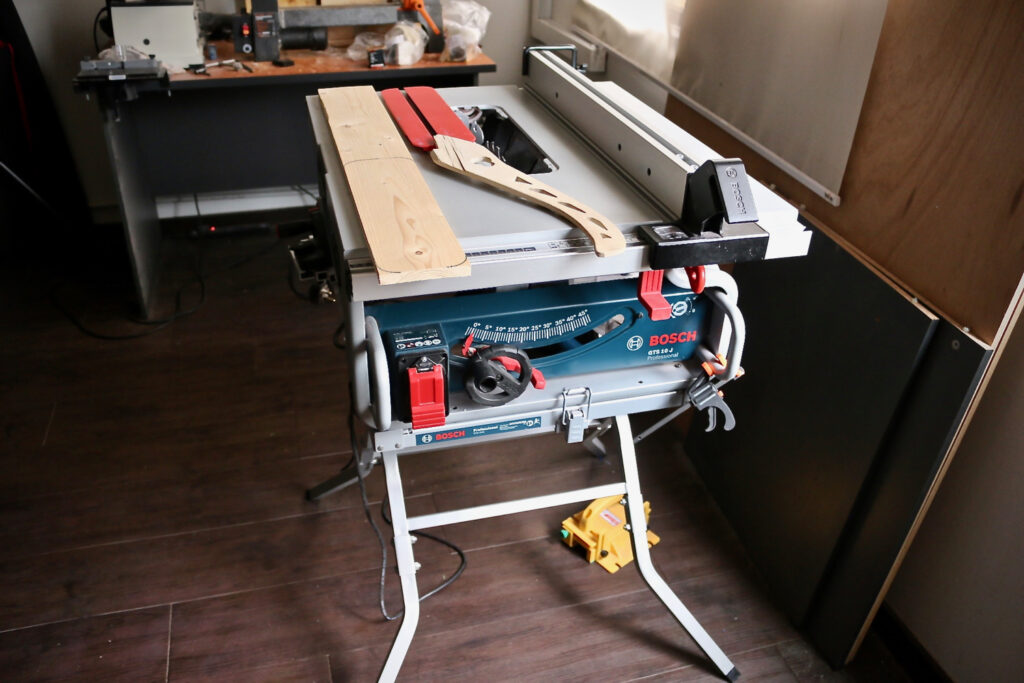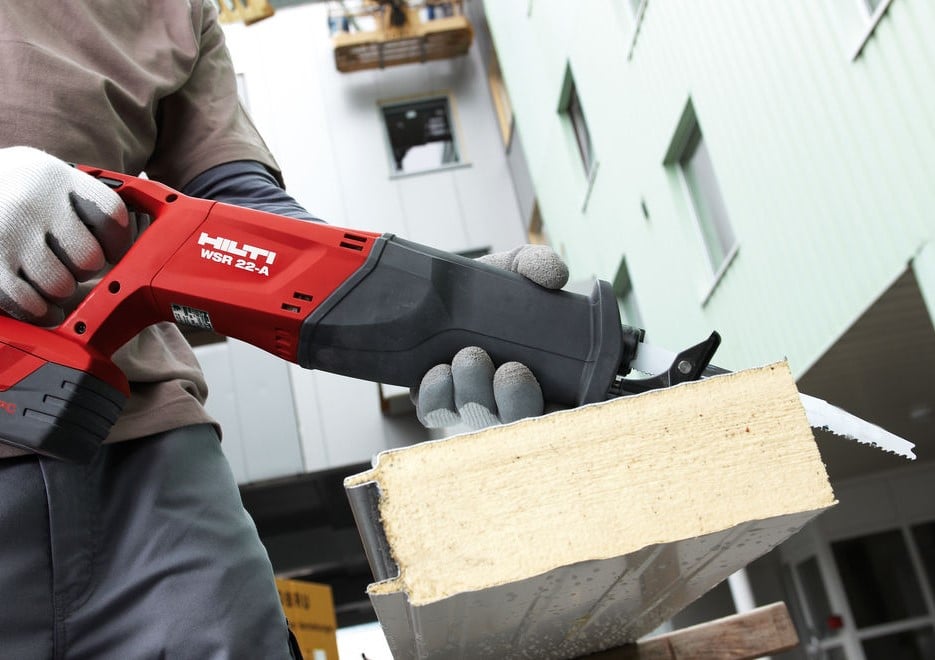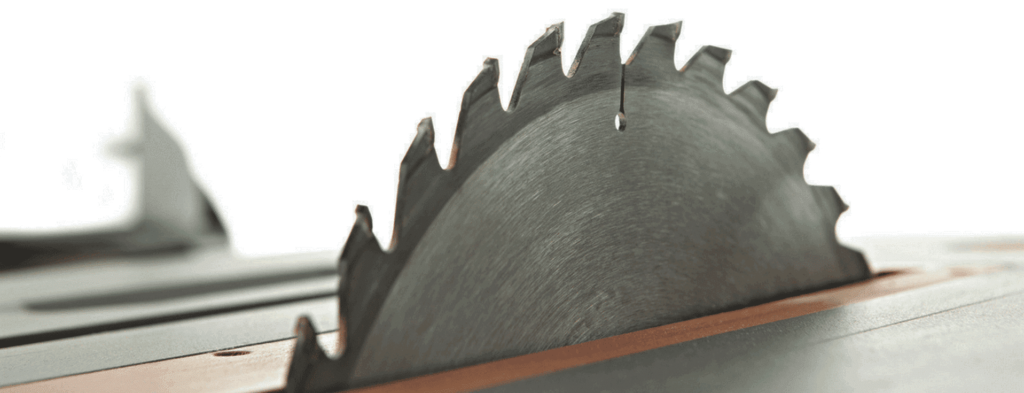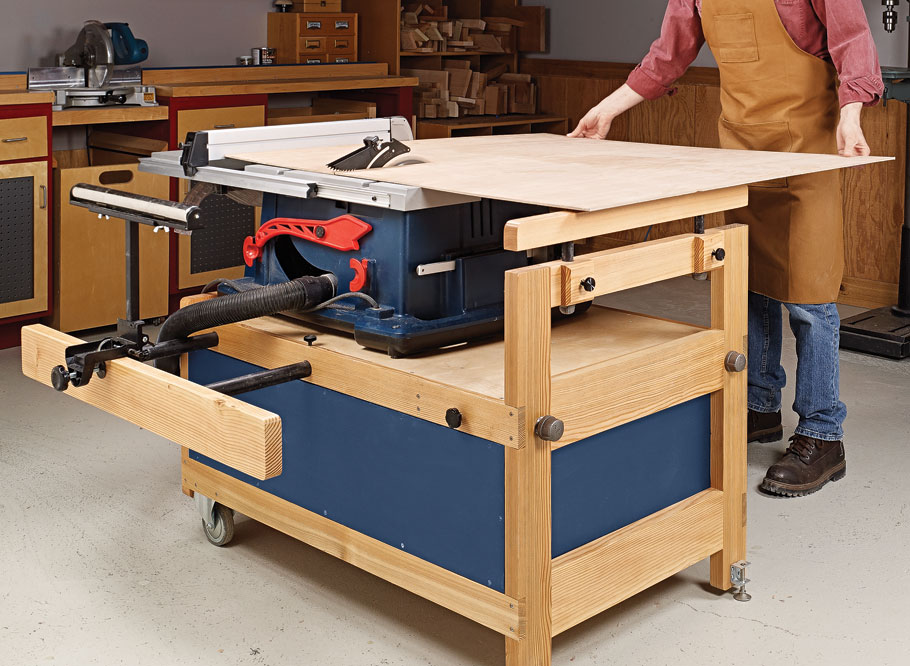Although tile saws look much like typical circular saws, the trick to tile saws is that they use a diamond cutting blade rather than a typical carbide blade and hold the cutting surface over a cooling pan of water.
We narrowed 14 models down to 5 of the best tile saws, highlighted in the table below with the top one the DEWALT D24000S. We first looked at size and weight, which determine how easy it will be to move your tile saw around to wherever you need it or to store it in between projects. We also looked at motor power and blade speed, which affect the length of cut you’ll be able to make without risking burnout, as well as the blade size and depth of cut, which determines the thickness of tile you will be able to cut.
More features: removable cutting cart, side and rear water tray
It’s hard to beat this powerful wet tile saw from Dewalt if you are frequently working on tile projects. The saw is heavy and large at 69 pounds and three feet long, but it boasts a 1.5-horsepower and a 10-inch diamond blade that spins at an impressive 4,200 rpm for clean and smooth cuts. Users also appreciated the removable cutting cart, which can be purchased with the saw for an additional cost, for saving their backs during long projects. However, note that the moderate weight is thanks to alloy construction, which is not as durable as the high-grade aluminum found on other saws.
One of the things that users love most about this tile saw is its precision. The top of the saw features cut line indicators to make finding your cut without time-consuming measuring easy, and the stainless steel rollers make it easy to feed tile without adding excess vibration. Users also note that the saw comes perfectly aligned out of the box, which is a huge advantage over cheaper saws.
The Dewalt saw is also capable of making bevel cuts at 22.5 and 45 degrees to give you more flexibility in your tiling work, and the dual side and rear water trays keep the blade cool whether working on straight or bevel cuts. As for many saws, users note that the blade that comes with the saw is poor quality and must be replaced quickly. Dewalt offers a three-year warranty, which is appropriate given the higher cost of this saw.
More features: hydro lock water containment system, sliding side extension, adjustable rip fence
If you need a tile saw specifically for working on an at-home DIY tiling project, this saw from SKIL provides nearly all of the features you need at a price that won’t break the bank. At only 24 pounds and less than two feet across, this saw is straightforward to transport from your garage to wherever you are working. While the one-horsepower motor is small compared to contractor-style tile saws, users note that it has no problem cutting through nearly any type of tile as long as you feed slowly and carefully. Plus, the seven-inch diamond blade provides a hefty ¾-inch maximum depth of cut so you won’t face issues with cutting the thickness of tile that you need.
The top of the saw is made from durable aluminum so you don’t have to worry about durability or precision when using the saw. Users appreciated that the fencing is adjustable to allow up to 18 x 18-inch tiles to be cut thanks to the sliding side extension. Plus, cleanup is kept to a minimum with this saw thanks to the hydro lock water containment system, although users caution that you’ll still want to put down a tarp around your workspace. Users also appreciated the flexibility of the saw for making bevel cuts – it has preset stops at 22.5 and 45 degrees.
The main downside to this saw is that the blade that comes with it is poor quality, so expect to invest in a new blade after just a few hours of use.
More features: snake-pipe water system, includes scissors stand
This tile saw from Lackmond is appropriately titled the “Beast” thanks to its powerful 1.25-horsepower motor and ability to execute a 24-inch rip cut within the extendable fencing. The saw is just over 60 pounds, but nearly four feet in length, so it may be at the limit of what many tile professionals can carry on their own. However, this size offers a massive workspace and Lackmond – and users – note that the seven-inch blade can stand up to most 10-inch tile saws on the market in every respect except depth of cut. However, most users found no need to cut tile thicker than the hefty 2-3/8-inch thickness allowed for by this saw and loved the speedy 5,300-rpm blade.
In addition to making 24-inch rip cuts, this saw outperforms other tile saws by being able to make a diagonal cut on an 18 x 18-inch tile – the maximum rip size of most other saws. The saw surface is rubberized to prevent slipping, but users note the steel rollers work well for feeding tile without awkward sticking. Lackmond also uses an innovative snake pipe water system that allows users to tightly control the amount of water that is hitting the blade and where it is hitting, although customers note that this can make it more difficult for beginners to use properly.
Lackmond includes a scissor stand with the saw to help save your back on extended projects and the company offers a one-year warranty on their product.
More features: motor thermal overload protection, built-in 3 gallon per minute water pump
If you need to be absolutely sure that you can cut through any hardness and thickness of the tile, there are few tile saws more powerful than this industrial model from Chicago Electric. The 2.5-horsepower motor far exceeds the power output of all other tile saws we reviewed and is able to spin a heavy 10-inch diamond blade to 3,800 rpm. Plus, the saw is able to make 3.5-inch deep cuts without faltering or overheating thanks to the extra motor power. Like the Lackmond saw, this tile saw has the ability to make 24-inch rip cuts and diagonal cuts on tiles up to 18 x 18 inches.
To cool the blade when working through heavy-duty tile jobs, Chicago Electric equipped this tile saw with a three-gallon per minute water pump. However, users noted that this pump can be quite finicky and the water demands of the saw require that in addition to carrying the 70-pound saw you carry multiple 10-gallon buckets of water for it to draw from. The saw is also equipped with thermal overload protection on the motor to ensure that the saw does not overheat and lives to its expected lifespan.
Another concern with this saw is the customer service. Users note that the saw comes with only a 90-day warranty and many people report receiving the saw with several parts missing. Users also note that the saw does not come with a blade, so plan to add that expense into the total cost of the saw.
More features: steel table and frame with rubber foot pads
If you only need a tile saw for a small DIY project, this budget-friendly tile saw from QEP is a great choice for the price. The saw is small and portable at just 22 pounds and 20-inches across, making it easy to move it to your work area or to store it in the garage once your project is finished. With the small size comes a small 0.75-horsepower motor and a seven-inch blade that only spins at 3,600 rpm, so be aware that you won’t be able to cut through thick slabs of particularly hard tile with this saw.
Users appreciated that this saw has an extendable rip fence that allows cutting of tiles up to 18 inches, but also found that making precise rip cuts can be difficult since there is a lot of wobble in the fencing. The measurement indicators on the saw are also few and far between, so plan to make your own markings when lining up tile for cuts. However, the steel table is relatively durable and the rubber foot pads do a good job of dampening vibration to the saw as long as you are okay working on the floor.
Users also noticed that the water cooling system is hit or miss. For many users, the blade stalled from overheating and clogging with dusty water after a large volume of tiles. However, with careful use and for small jobs this was not a prevalent issue.
When it comes to cutting tile, there is virtually no replacement for having a good tile saw. Although tile saws resemble traditional circular saws, using a circular saw to cut tile will leave you with a pile of crumbled, marred tile – not to mention a badly damaged saw blade – thanks to the hardness and brittleness of this materials. A table saw uses a diamond blade rather than a traditional carbide blade in order to provide better durability when cutting through the tile. In addition to the different material, a diamond blade on a tile saw actually chips away at the tile rapidly rather than trying to slice through it as for wood and metal.
Plus, tile saws characteristically have a water bath beneath the saw blade that helps to keep the blade cool – an important aspect when cutting through lots of tiles. The water also serves to soak up dust so that the blade and your saw’s motor do not become clogged and overheat.
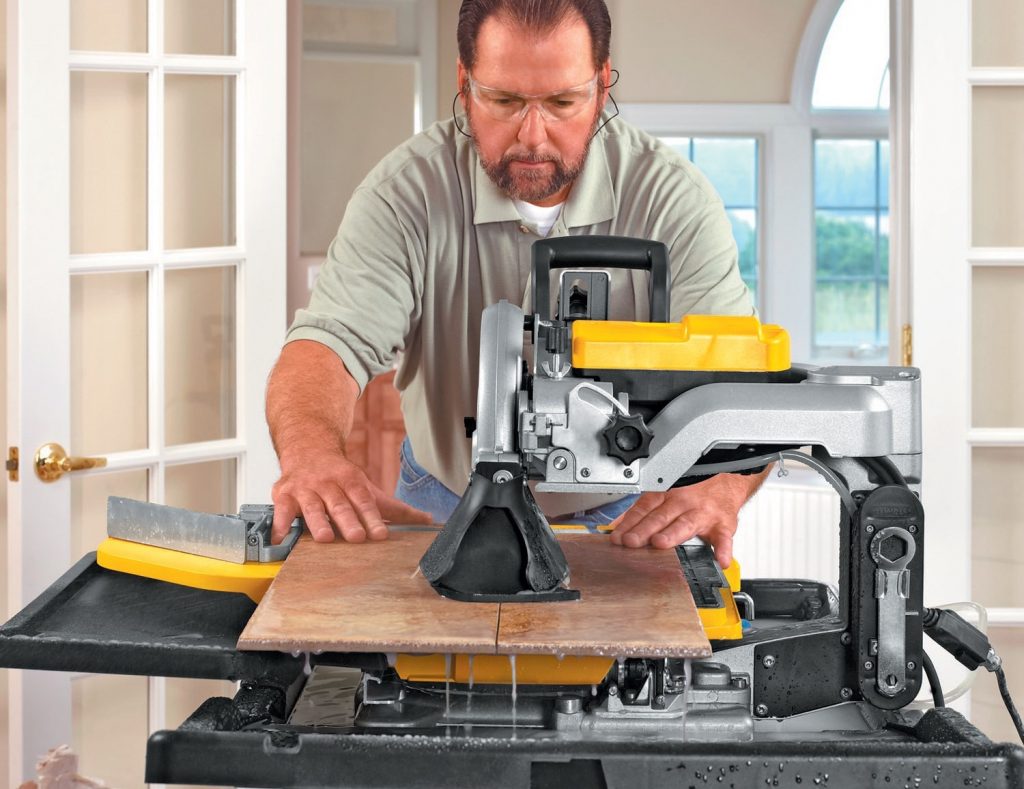
Where you plan to use your tile saw is one of the main determining factors in what type of saw you will need. For contractors and professional tilers who are constantly working on large jobs, a stationary saw mounted on a stand or a bench offers the most power. However, these saws also typically require access to a steady supply of running water in order to keep them running coolly. On the other hand, handheld tile saws are a great choice if you are only working on a small project around your house or if portability is a paramount concern for you. Of course, portability comes at a price of power and convenience, since it also takes a lot of pre-cutting work to make sure that the small water reservoirs on these saws are filled and that they remain steady when cutting.
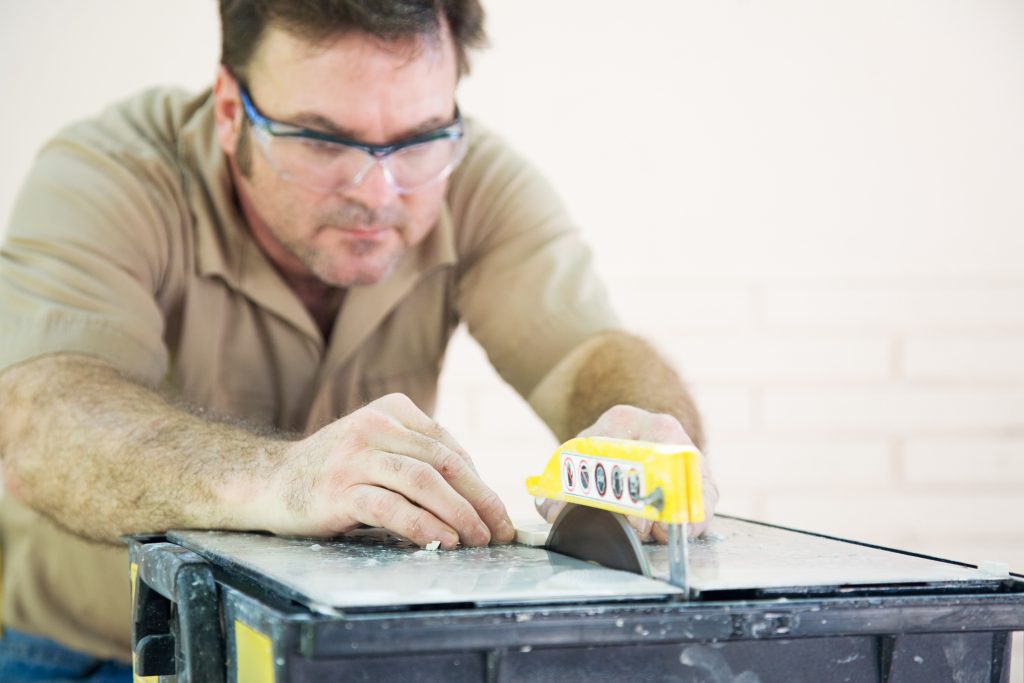
For first time tile saw users, there are a number of differences from traditional circular saws that can make them especially tricky to get a handle on. First, you need to decide if you need to use a manual dry tile cutter or a wet saw – most projects only require one or the other, although there may be instances in which you need both. If you only have small, straight cuts to make, a manual scoring tool will typically do the trick. With a little practice at running the scoring wheel over the cut a few times and then pressing down firmly to break the tile, you can make good, clean cuts relatively quickly. For larger jobs, though, you’ll want to use a wet saw.
Whenever using a wet tile saw, overspray is an issue. The best way to deal with this is to place a tent over the entire saw or, in enclosed spaces, to place a tarp behind the saw. You’ll also want to make sure that the blade is wetted before starting on any cuts to preserve the lifespan of your blade. When making cuts, be sure to feed the tile into the blade extremely slowly with two hands on the close end of the tile. The harder the tile material, the slower your feeding rate should be.
Safety is a big concern with every saw, tile saws included. Like for any saw, you should be sure to wear appropriate clothing – like a sturdy apron – and eye protection to keep yourself safe from any flying saw debris. Ear protection is also a good idea to protect your hearing. While gloves are not strictly necessary, many people find that they help when working with tile because there are many sharp, rough edges that form. Safety boots are also worth considering if you will be working with heavy slabs of tile that could fall on your toes in an accident.
When feeding tile into the blade, be sure to keep your hands on the end of the tile closest to you to keep it steady and always leave plenty of space between your fingers and the blade.
Tile saws range from heavy-duty stationary saws to small and portable tile saws, so it’s important to understand the features that differentiate saws in order to find the right tool for your project. Here, we’ll cover some of the main features that differentiate tile saws and explain how they can affect a saw’s performance.
Tile saws range in size from massive stationary saws like the Lackmond Beast BEAST7CKIT saw to small, portable saws like the QEP 22650Q 650XT saw. There are important differences in usability between these saws, since the size is often reflective of motor power and the size of the water reservoir, but size can also be important simply for determining if the saw will fit in your garage or in the area where you’ll be working. For many people working at home, the cons of having a massive and powerful stationary saw outweigh the benefits of being able to transport a small, lightweight tile saw into the area where you will be laying the tile once it is cut.
Tile is an extremely hard and brittle material, which makes the power of your saw all the more important. A more powerful saw, like the 2.5-horsepower Chicago Electric 95385 tile saw, will be able to cut through thicker slabs of tile and make longer cuts without wearing down and overheating. While this might not be important for small tile jobs, for contractors working with large volumes of tile at a time it can make or break the saw.
Unlike traditional circular saws, which typically come with carbide-tipped blades, tile saws come with diamond-tipped blades. These blades are more durable when cutting through the hard, brittle material that is tile. Plus, the teeth on these blades are designed not for slicing through the material you are cutting, as on a circular saw, but rather for rapidly chipping away at the tile.
The blade size is an important consideration for three reasons. First, it will determine how much momentum the saw blade carries with it – a larger blade, like the 10-inch blades found on the Dewalt D24000S and Chicago Electric 95385 saws, spinning at a higher rotation rate will have more momentum and thus will be able to cut through thicker, harder tile with less difficulty. The second reason to consider blade size is that it will determine the maximum depth of cut that your saw is capable of – a larger diameter blade will typically have a larger maximum depth of cut. Third, a larger blade actually has more time in each rotation before it comes in contact with the tile again, giving it more time to cool. Although this might seem minuscule, it can make a big difference in the longevity of the blade.
One of the things that manufacturers can do to make their blades more versatile is allowing you to change the blade out for a blade of a smaller diameter. Although this is not likely to be a feature that you use regularly, it can make a big difference when you need to make small, precise cuts in tile.
The depth of cut describes the maximum thickness of tile that a blade is able to cut through. Since tile saws depend on water cooling from a tray beneath the tile, it is not advisable to cut through a slab of tile longer than the maximum rated depth of cut. The depth of cut is typically related to blade diameter, which is why the Dewalt D24000S and Chicago Electric 95385 saws have the largest depths of cut out of the tile saws we reviewed.
The rip capacity of a tile saw is determined by the maximum distance from the saw blade to the fence when it is placed at its further extension. Thus, the rip capacity describes the widest section of tile that you can cut, which can be an important consideration if you are planning to lay large slabs of tile rather than small squares.
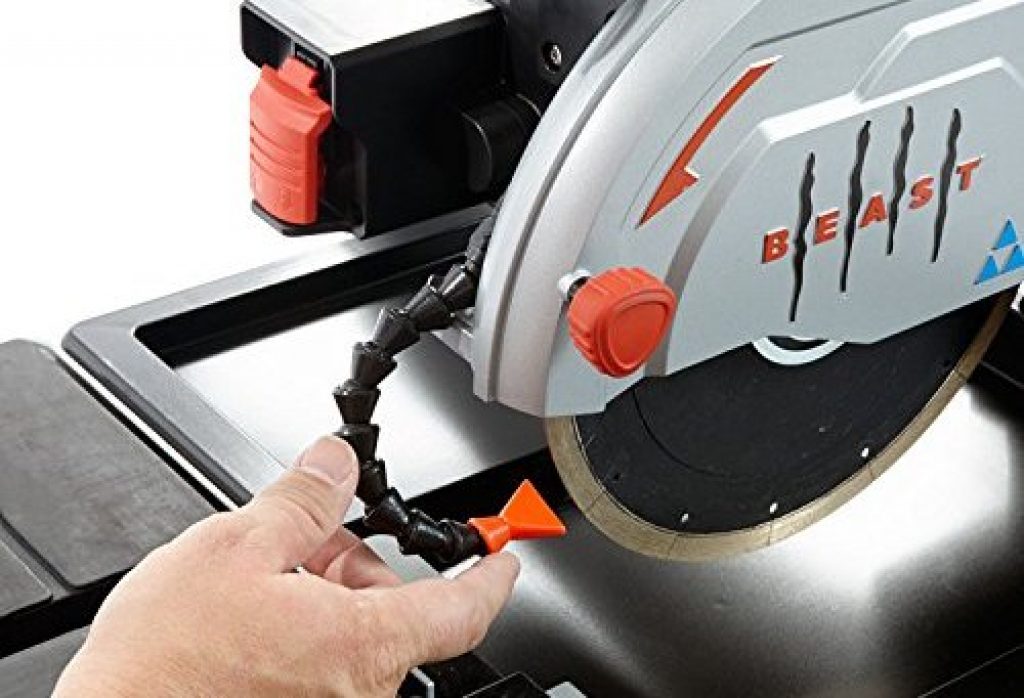
There are two main ways in which tiles saws provide water to the blade. The first method uses a reservoir of water with a pump attached to it, which pumps water to and away from the blade so that you are continuously adding cool water. This is a great option when you do not have a continuous water supply available, but this method requires that you keep a close eye on the water reservoir and refill it after every set of cuts. The second method uses a continuous hose line running to and away from the water basin in the tile saw. This is extremely convenient and efficient but does require access to a steady supply of running water.
The weight of the saw is another factor affecting its portability since, as you might expect, heavier saws like the models from Dewalt D24000S and Chicago Electric 95385 will be hard to move around and even more difficult to move to upstairs work sites. However, these heavier saws can also be more stable, especially since they are mounted on work stands.
One of the major advantages to a tile saw’s versatility is the ability to make beveled, or angled cuts. While some high-end saws will allow you to make cuts at any angle between zero and, for example, 45 degrees, other saws, like the Chicago Electric 95385, has specific bevel angles – in this case, 22.5 and 45 degrees.
The arbor is the shaft that the saw blade is mounted on. In general, it is best to choose a tile saw that uses a standard 5/8-inch diameter arbor since there is the largest selection of blades of all diameters for this arbor size when it comes time to replace your saw blade.
As you might expect, accuracy is extremely important when making cuts in any material – not just tile. The accuracy of a tile saw depends on everything from the precision of the fencing and blade to the tightness of all the bolts in the saw. The best way to check whether a tile saw makes accurate cuts is to consult user reviews since contractors and hobbyists alike will note if a tile saw is not accurate.
The voltage that a tile saw draws is typically a reflection of the size of the motor. Importantly, all of the tile saws that we reviewed can run on standard 120-volt outlets and do not require 240-volt shop outlets.
A tile saw is a significant investment in your toolkit, so you want to be sure that the saw you are buying will last for years to come. Most manufacturers offer some length of warranty on their saws to provide peace of mind with your purchase, although these warranties range from only 90 days for the Chicago Electric 95385 saw to three years for the Dewalt D24000S saw.
Feel free to add something you think is important and relevant, and please mention some of the products reviewed as examples in the buying guide, where appropriate.
Our overall favorite tile saws are the Dewalt D24000S, the Lackmond Beast BEAST7CKIT, and the SKIL 3550-02. Although both the Lackmond Beast BEAST7CKIT and SKIL 3550-02 saws are both seven-inch tile saws, they are best for very different purposes. The SKIL 3550-02 saw is small and portable, perfect for DIY jobs at home or as a portable tile saw for contractors. The Lackmond Beast BEAST7CKIT saw, on the other hand, is much heftier and has the ability to make massive 24-inch rip cuts with excellent precision. Plus, the larger motor and fast blade speed on that saw allow it to compete with many 10-inch blades and cut through nearly any hardness of tile. We feel that the Dewalt D24000S tile saw is the overall best tile saw Trusted Source 5 Best Wet Tile Saws - Sebring Design Build Check out our review of the best wet tile saws you can purchase online. Check out their pros and cons, as well as our tips to help you get started. sebringdesignbuild.com on the market today because of its 1.5-horsepower motor and 10-inch diamond blade that provides a significant depth of cut. Plus, Dewalt D24000S offers a solid three-year warranty to protect your purchase.
